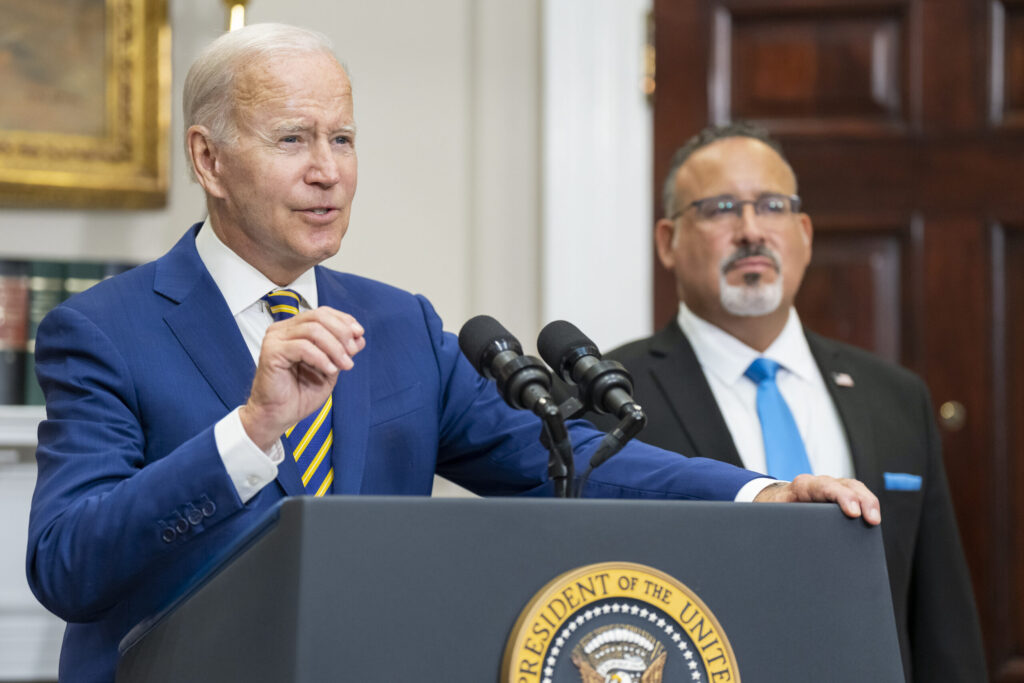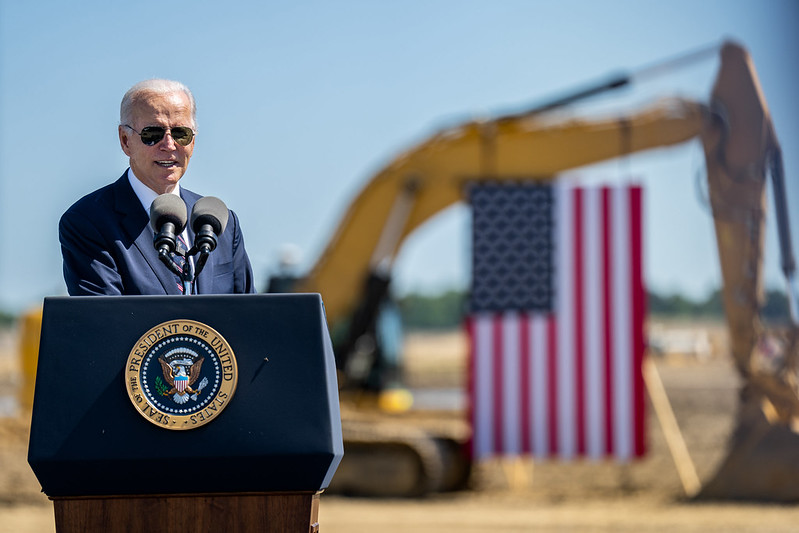
Two years in and a changed Congress—How does Biden stack up and move forward on transportation?

The sunsetting 117th Congress passed historic investments in infrastructure, via the 2021 infrastructure law and the Inflation Reduction Act. In parallel, the Biden Administration has rolled up its sleeves to implement those infrastructure investments with an eye towards safety, repair, and equity. Now with the incoming and divided 118th Congress, the Biden team is running out of time to make inroads on advancing its goals.

Since our last check-in, Congress passed the Inflation Reduction Act, FHWA finally has a confirmed administrator, and USDOT proposed a greenhouse gas emission rule which garnered thousands of comments in support. Meanwhile, USDOT continues to send out billions of dollars in formula and competitive dollars from the infrastructure law.
However, with two years left in Biden’s term, time is running out for the administration to take decisive action on its transportation priorities. Progress made has been uneven and timid at best, concerned about political acceptance at the state and federal level instead of achieving the goals they’ve outlined. With one year down and four more to go for the IIJA, Biden’s USDOT will have to get creative to influence state DOT implementation of the law while also facing stiff headwinds from an incoming GOP-led House, bent on obstructing transportation spending that is counter to a car-centric status quo.
The good: Taking steps to advance equity and climate in transportation
Recognizing local capacity constraints, USDOT invests in Thriving Communities
Thanks to Congressional appropriations in FY22, USDOT has created the Thriving Communities program to bridge the gap for marginalized communities to pursue and manage federal grant opportunities by building local capacity and providing technical assistance. This program is a $25 million down payment on an equitable and accessible discretionary grant framework for all communities, regardless of capacity and resources.
Long overdue proposed rule aims to advance climate accountability
In July 2022, the Biden administration proposed reinstating a rule that would require states to track their greenhouse gas (GHG) emissions. Save from a few minor adjustments, this 2022 version parallels the previously enacted Obama administration GHG emissions rule. FHWA is in a solid position to officially implement the proposed rule, especially because 24 states and the District of Columbia (not to mention local and regional instances) have already implemented it on their own. The rule is imperfect and limited in scope, but is nonetheless a crucial step towards intergovernmental climate accountability.
Money and action on Reconnecting Communities
The IIJA also included the Reconnecting Communities program, an effort to repair the harm done by divisive transportation infrastructure that destroyed community wealth and vibrant cultural centers for black and brown communities. The USDOT started rolling it out with a NOFO in late June. Congress doubled down on this effort by passing the Neighborhood Access and Equity Program (23 USC 177) in the Inflation Reduction Act. Furthermore, USDOT took a notable step within its RAISE program to demonstrate its commitment to Reconnecting Communities by investing in a project in Detroit and another project in NYC that aims to remove divisive highway infrastructure and restore community connectivity and vibrancy. In lieu of just making money available, USDOT is showing up in its leadership to steer the transportation program towards meaningful actions towards Reconnecting Communities.
The incomplete
Perfection is the enemy of the good
The above actions are commendable, but will do little to change state DOT investment strategies. Much of this past year, USDOT has rolled out new and updated guidance for various formula and discretionary grant programs stemming from the 2021 infrastructure law. At the same time, USDOT has been sending out a deluge of requests for information, with little followup action stemming from such requests. The search for the perfect approach to implement the infrastructure law has sapped up considerable precious time and stirred up opposition to administrative actions, in lieu of taking bold steps.
In the same vein, the much-anticipated MUTCD update is still pending. Rather than spend months overhauling the entire manual, USDOT should push ahead and release updates to the manual that advance a safe systems approach, put vulnerable road users first, and continue to make progress.
Non-representative Amtrak Board appointments
The 2021 infrastructure law reoriented Amtrak to focus on customer service and connecting communities across the country, both rural and urban. This reorientation included new standards for the composition of the Amtrak Board, which now must include representatives from not only the Northeast Corridor (NEC), but also the National Network (both long distance and state supported routes), as well as representation from the disability community. Unfortunately, the administration’s nominees, with the exception of one nominee from Illinois, hail exclusively from states served by the NEC. It will be up to the remaining nominees coming from Republicans to rebalance the Amtrak Board to steward its customer oriented, community connecting mission.
Lots of focus on moving goods, but what about moving people?
Supply chain has been the transportation buzz term of 2022, with logistical and labor hurdles in goods movement from the nation’s ports, to the freight railroads, to last mile delivery in communities across the US. The administration and Congress dove in and spent considerable time and money to improve resiliency of the nation’s supply chain. But at the same time, there has been an acute and worsening crisis in transit operations.
Transit is a lifeline in many communities, ferrying essential workers to work and carrying lower-income members of the community to essential community services. Akin to the administration’s leadership on addressing challenges in the nation’s supply chain, the Biden administration needs to take leadership to address the nation’s transit operations across the country.
The opportunity: Actions the administration can take right now
Our list of specific actions are in the table below, tracking the progress the Biden administration has made since taking office. Since our last update, not much has changed (and there’s a notable lack of progress on value of time guidance and ensuring models account for induced demand, both of which we highlighted in our six-month update).
| Issue area | Department | Status | Detail | Action |
|---|---|---|---|---|
| Access to federal funds | USDOT | Simplify applications for discretionary grant programs (like the Better Utilizing Investments to Leverage Development (BUILD) program) by creating an online application and benefit-cost analysis (BCA) process so that small, rural and limited-capacity agencies can more easily access federal funds. | ||
| Climate change | USDOT | In progress | Started rulemaking process | We only measure what we treasure. Re-establish the greenhouse gas (GHG) performance measure for transportation abandoned by the last administration, follow this up with annual state GHG rankings, and provide guidance for projecting GHG emissions at the project level. |
| Climate change | USDOT | Done | Repeal the June 29, 2018, Federal Transit Administration (FTA) Dear Colleague to public transit agencies regarding the Capital Investment Grant program, specifically the treatment of federal loans as not part of the local match, inclusion of a geographic diversity factor in grant awards, and encouraging a low federal cost share. | |
| Climate change | USDOT | Allow rural transit systems to receive funding from the Low and No Emission bus program. | ||
| Equity | USDOT | Identify infrastructure that creates barriers to mobility (such as highways or rail beds that divide a community). Then prioritize resources to address those barriers and the disparities they create (e.g., by removing infrastructure barriers or creating new connectivity). | ||
| Passenger rail | White House, USDOT | The board is functionally empty, with all members serving on expired terms and no-showing for meetings. | Appoint new members to the Amtrak Board of Directors and assess the balance of the board with respect to support for and experience with vital long distance, state-supported, and Northeast Corridor routes, as well as civic and elected leaders from local communities actually served by the existing network. | |
| Safety | USDOT | Limited progress | Called out in Roadway Strategy release, but they did not include or mention consideration of the visibility issues. | Revise the New Car Assessment Program to consider and prioritize the risk that increasingly larger automobile designs pose to pedestrians and cyclists and the driver’s ability to see pedestrians (particularly children and people using wheelchairs and other assistive devices). |
| Safety | USDOT | Limited progress | Comments reopened and then closed in May 2021. Limited revisions underway Admin not rewriting or reframing the guide, per their Roadway Strategy release. | Reopen the comment period on the handbook of street engineering standards (the Manual on Uniform Traffic Control Devices or MUTCD) used by transportation agencies to design streets, and reframe and rewrite it to remove standards and guidance that lead to streets that are hostile to or dangerous for those outside of a vehicle. |
| Technical guidance | White House, HUD, USDOT, GSA | Re-activate the Location Affordability Portal created by DOT and HUD and establish a location efficiency and equitable development scoring criteria to be applied to decisions involving location of new federal facilities, particularly those that serve the public. | Re-activate the Location Affordability Portal created by DOT and HUD and establish a location efficiency and equitable development scoring criteria to be applied to decisions involving location of new federal facilities, particularly those that serve the public. | |
| Ensure more accurate traffic and emissions modeling | USDOT | Require the measurement of induced demand and a review of the accuracy of current travel demand models by comparing past projections with actual outcomes, reporting their findings, and updating the models when there are discrepancies. | ||
| Replace value of time guidance with more equitable, multimodal approach | USDOT | Help states and metro areas accurately calculate the benefit of their projects by updating the value of time guidance and its focus on vehicle speed with consideration of actual projected time savings for all people, whether they travel by car or use other modes of travel. |
Looking ahead into 2023, the administration will be put on defense with what could be a hostile GOP-led House, bent on overzealous oversight aimed to claw back any progress on administration goals and implementation of the 2021 infrastructure law. Instead of being timid on their actions and allowing oversight to overwhelm USDOT’s agenda, USDOT will need to lean in and flex as much of their authority as they can in advancing their goals; forcing Congress to confront challenges to the administration’s flexed authority in the next session in a bipartisan manner and cultivate a reckoning within the federal transportation program that will sorely need to be revisited in the next transportation reauthorization.



